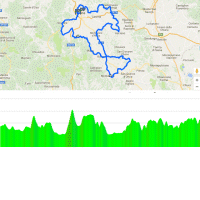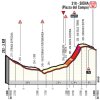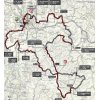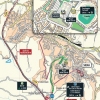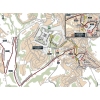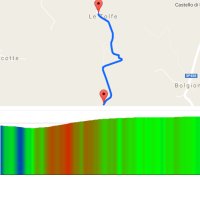Strade Bianche starts in arrival town Siena. Riders get on their bikes and leave the ancient town to enter a race with medieval characteristics. In the rolling landscape of Tuscany the toughest sections are on unpaved roads. The first one comes after 17.1 kilometres, 2.1 kilometres and perfectly straight, but offering a solid way to get warmed up to the hardships ahead.
The day’s first climb coincides with the second sector. It’s 5.8 kilometres on climbing gravel and the steepest ramps are 10%. Following two flat to descending stretches of dirt road – respectively 4.4 and 5.5 kilometres – the Strade Bianche tackles its second climb. This one is on tarmac and leads to the fortified town of Montalcino. The distance is 4 kilometres and the average gradients.
After the drop the longest dust sector lays waiting. Lucignano d’Asso amounts to 11.9 kilometres on winding roads with fields and forest left and right. Just 1 kilometre of tarmac and then the next gravel sector brings something extra to the mix. At 8 kilometres, it’s a punchy sector taking in both climbing and descending.
Some 11 kilometres of flat tarmac brings the riders to the next gravel stretch. At 9.5 kilometers and mostly uphill, this one will weary the legs still further. It goes up and down in the first part and ends with a twisting climb before meeting the tarmac again.
At kilometre 130 the endgame begins with the presence of the Monte Sante Marie climb. Sector 8 amounts to 11.5 kilometres and is arguably the toughest of all sterrati at the Strade Bianche. It runs mostly uphill, although the strip also features some nasty descents. This sector is a good spot to attack, but one mistake and you’ll hit the earth.
When the riders leave sector 8 they face approximately 20 kilometres on tarmac. Which may sound better than it actually is, as the route is either going up or down, while heading to the last three stretches of unpaved roads.
The first one doesn’t really count as it’s just 300 metres and flat, while sector 9 is – at 800 metres – not too long either, yet it’s spiced up by a double digit gradient ramp before hitting the tarmac in Vico d’Arbia.
The Strade di Colle Pinzuto is the penultimate dust stretch. It amounts to 2.4 kilometres and the steepest ramp of 15% lies at the beginning. But no time for a breather after this, as the road continues to rise gradually until the end of it.
Last year, Michael Kwiatkowski attacked shortly after the Strade di Colle Pinzuto. He took off stealthily from a front group with Tim Wellens, Greg Van Avermaet, Zdenek Stybar, Tom Dumoulin, Luke Durbridge and Christopher Juul-Jensen, who only saw him again after the finish in Siena.
The last gravel road is a 1.1 kilometres toil, opening with a short descent and closing with the 18% gradients of the Le Tolfe climb.
All sterrati are history and still 12 kilometres to go. If any escapees are adrift, the winding roads of Tuscany favour them, as chasers will have difficulty pinpointing the attackers.
With 5 kilometres to go the road goes downhill, only to go back up again in the last kilometre. Entering the city walls of Siena, a 16% sector welcomes the riders. Then a sharp turn to the right, left, and right again. The finish is at Il Campo, Siena’s iconic square that looks a bit like a theatre. What a finish to one of the most photogenic race on the calendar.
Read also: results/race report 2018 Strade Bianche.
Strade Bianche 2018: Route maps, height profiles, and more
Click on the images to zoom
